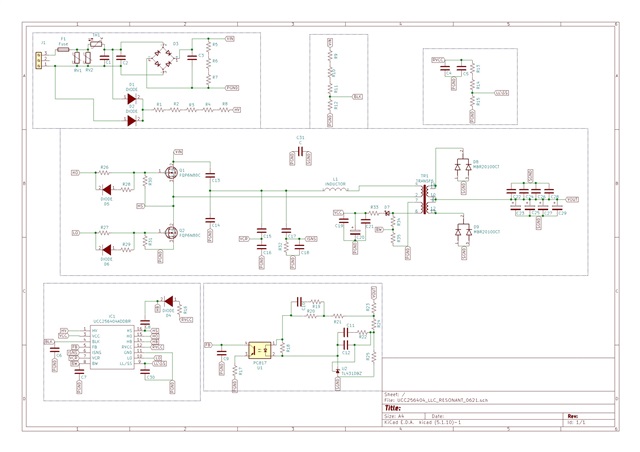Other Parts Discussed in Thread: UCC28070, UCC25640EVM-020
Hello
I am hoping someone who has experience with UCC256404 or TI mastermind could help me with the design.
Design Parameters:
DC voltage range: 260 315(nominal) 340 VDC
AC voltage range: 185 ~240 VAC
VOUT Output voltage - Normal mode Burst mode threshold to full load = 25 A 24 VDC
I am designing a UCC256404 based LLC Power supply for 24v 600watts at full load. I am not using the PFC boost UCC28070 for now and using a bridge rectifier and RC filter to get Dc nominal voltage at Vin .i am trying to get the UCC256404 to work but I am having a problem starting up the IC. Since I am not using the PFC boost correction phase so I have set the DC bulk voltage between 260V DC -340V DC at nominal DC input voltage as 315V.(220VAC~50Hz Mains).
I have calculated the values using the UCC25640x Excel sheet Calculator. Please find it attached below. I have connected a 24V DC Motor which works at 48Watts at the load. The resultant switching frequency(resonant) is ~98kHz.I have attached the schematic and BOM for reference. Can you please check and what could be the possible error for fault. From what I have analysed through the waveforms, I would like to make few points for you to review-:
1)Vcc turns and goes till 26 Volt and then settles down to 14.3V as calculated nominal bias winding but the RVcc pin jumps to 13.5V Mean(when Vcc is around 26V)and then goes low when Vcc settles to 14.3V.This is irregular with what is expected from RVcc as Rvcc needs to be constant at 13V when Vcc starts switching.(Reference:UCC25640EVM-020 Evaluation Module ,Literature Number: SLUUBX3B Fig7) .
Also I don't understand that why the Vcc voltage stays constant at 14.4 volt as the mosfets are not switching in steady state as discussed in point 3.Is it because the Elco capacitor connected to Vcc gets charged but I don't see it discharging even remotely. It seems to be constant voltage coming from the 3 number pin of the IC. Shouldn't it be other way around that the pin3 is the input pin and not the output.

2) The HB-HS pin starts with a pulse but eventually the signal dies after few ms.The HB-HS<17V is satisfied during those milliseconds. The following waveform appears-

Blue-HB Yellow-HS
I am also a little unsure of how HS-HB works. HS works as the ground for when high side gate drive current,right?This means it acts as ground when high side mosfet is on?
and HB acts as the high side gate driver floating voltage charged from Rvcc when the lower mosfet is on. What I don't understand is why the high side mosfet would need a floating voltage when it is turned off(ie when low side mosfet is conducting). The high side gate voltage should be not positive at that time as both the mosfets work as compliments to ensure zvs and llc resonant working condition.
3)I am not getting a startup LO pulse but rather an abrupt burst of HO and LO pulse. Please refer to the diagram below.

Blue-LO Yellow-HO
When the 24V 2Amp load is connected , and input AC voltage is at ~185VAC(~264VDC calculated Bulk startup voltage), the IC seems to restarts every second for the maximum number of counts(5-6) but when the input AC Volt is increased to 220VAC(315VDC-Nominal Vin), the IC stops with reducing number of restart counts.The rotor on the motor makes progressive minimum angle rotation at each restarting pulse from the IC.
4) The BLK pin seems to be working fine with Mean DC voltage at BLK pin =1.2V (Rblk lower=38kOhm Rblk upper=10MOhm and Cblk=10pF).
I have attached the zip file including the schematic,BOM, excel sheet calculator with my specs and the transformer specs.
Please help me debug the issue and let me know what I am missing.
Thanks in advance.







